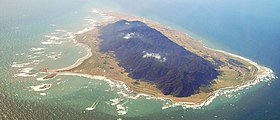Mocha (island)
| Native name: Isla Mocha | |
|---|---|

Aerial view of Mocha Island
|
|
| Geography | |
| Location | South-central Chile |
| Coordinates | 38°22′15″S 73°54′51″W / 38.37083°S 73.91417°W |
| Area | 48 km2 (19 sq mi) |
| Highest elevation | 300 m (1,000 ft) |
| Administration | |
| Region | Bío Bío |
| Province | Arauco |
| Comuna | Lebu |
| Demographics | |
| Population | ~800 |
| Ethnic groups | Chileans, Mapuches |
Mocha (Spanish: Isla Mocha) is a small Chilean island located west of the coast of Arauco Province in the Pacific Ocean. The island is approximately 48 km2 (19 sq mi) in area, with a small chain of mountains running roughly in north-south direction. In Mapuche mythology, the souls of dead people travel west to visit this island. The island today is home to the Mocha Island National Reserve, a nature reserve that covers approximately 45% of the island's surface. The island is noted as the location of numerous historic shipwrecks. The waters off the island are a popular place for recreational sea fishing.
Geologically the island is a basement high and it does also contains strata of Ranquil Formation whose main outcrops lie in the continent.
The island was historically inhabited by an indigenous coastal population of Mapuches known as the Lafkenches. It was discovered by Juan Bautista Pastene September 10, 1544, and named Isla de San Nicolas de Tolentino.
According to Juan Ignacio Molina, the Dutch captain Joris van Spilbergen observed the use of chilihueques (a South American camelid) by native Mapuches of Mocha Island as plough animals in 1614.
Mocha Island was regularly visited by pirates from the Netherlands and England. Francis Drake and Olivier van Noort are known to have used the island as a supply base. When Drake was visiting it during his circumnavigation of the globe he was seriously hurt by hostile Mapuches that inhabited the island. Eventually the Mapuche on the island were transported in 1685, from Mocha Island by Governor José de Garro to a reducción on the plain on the right bank of the Bio Bio River called the Valley of Mocha that later became the location of the modern city of Concepcion, Chile.
...
Wikipedia
